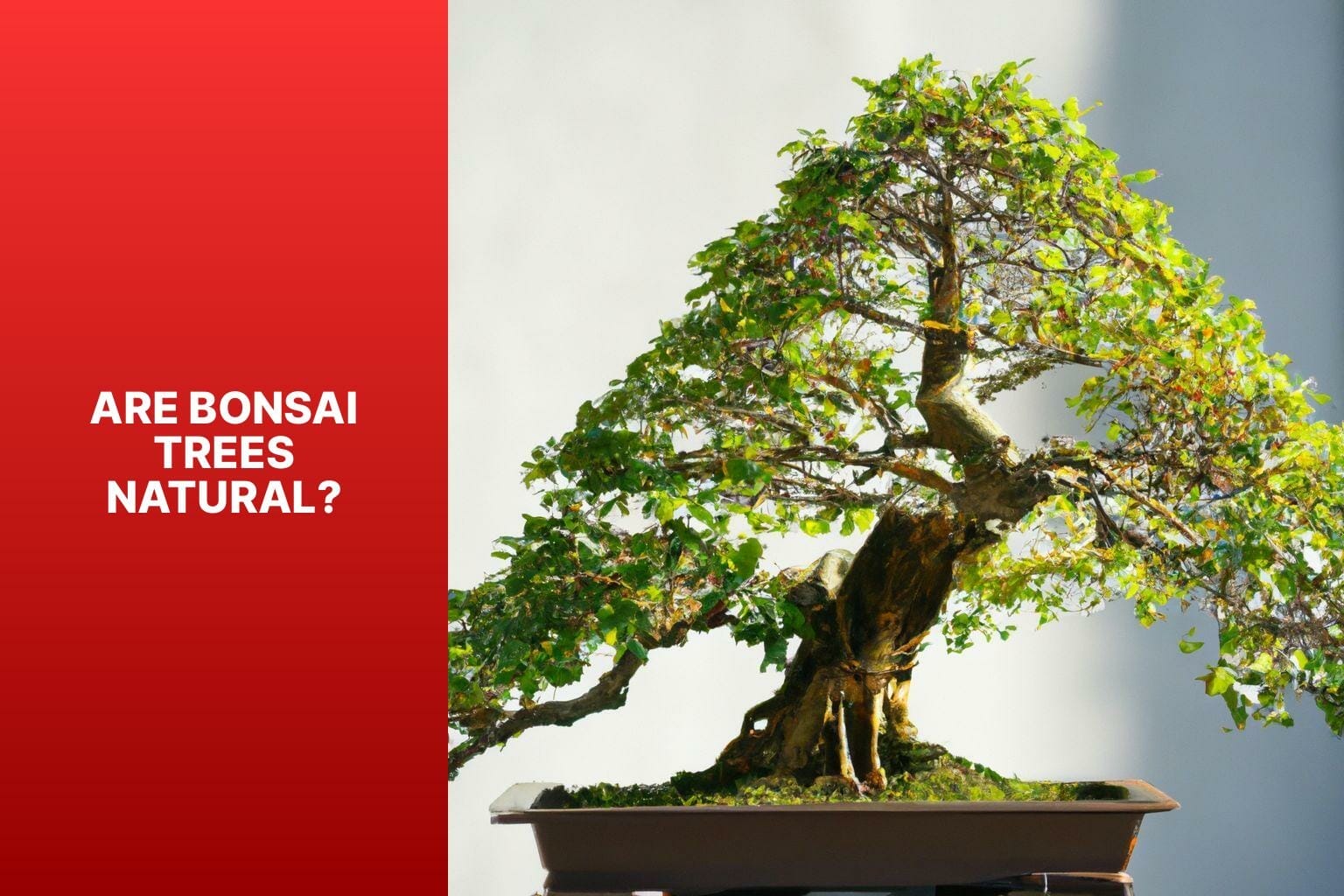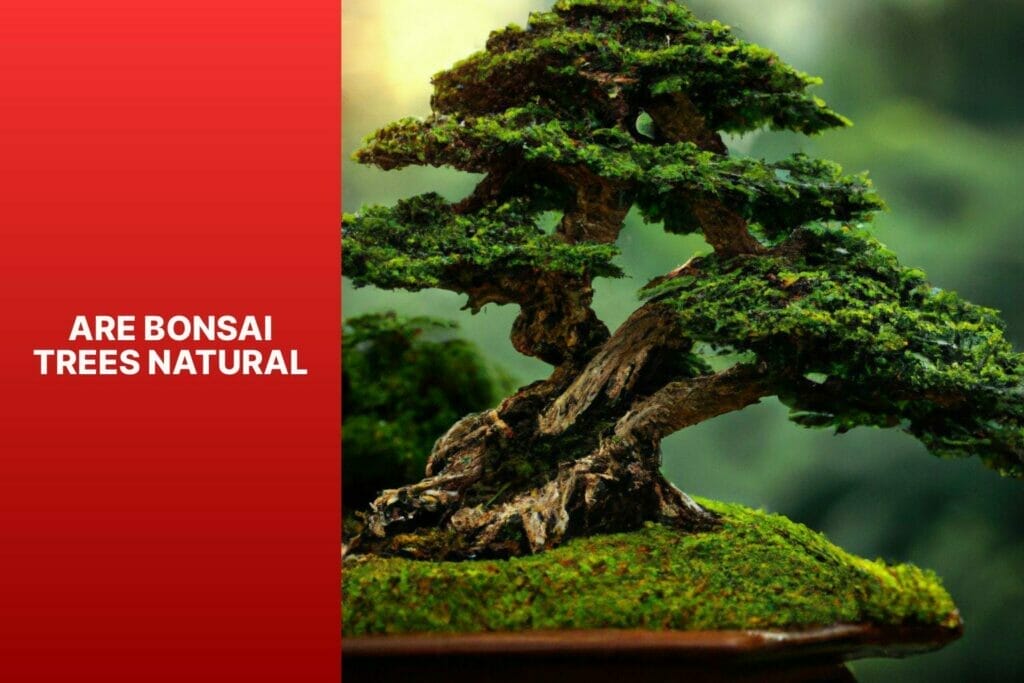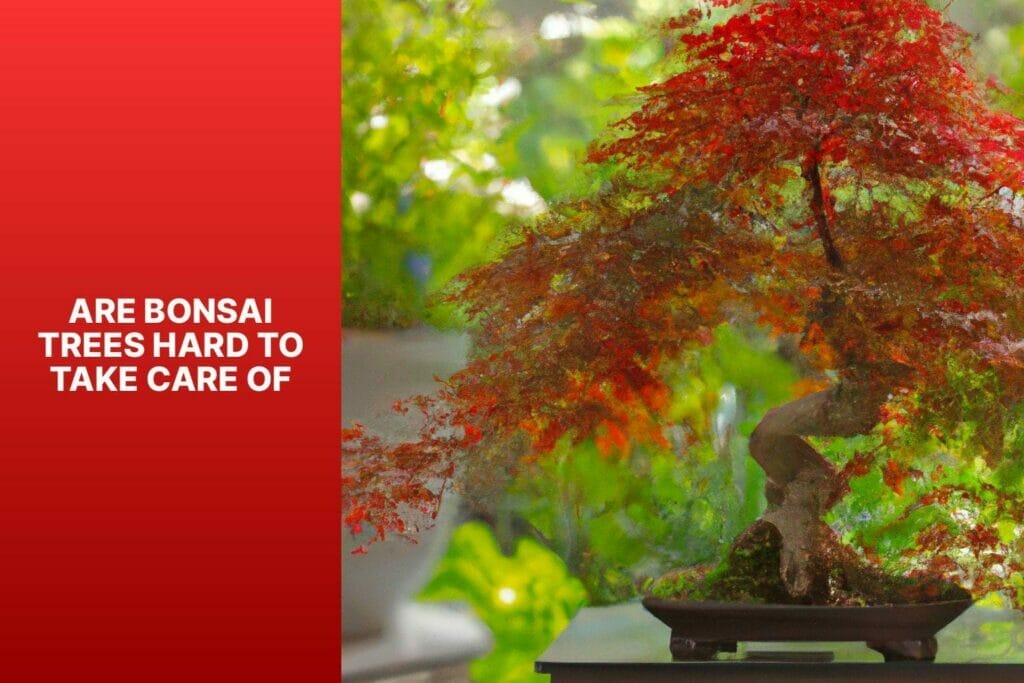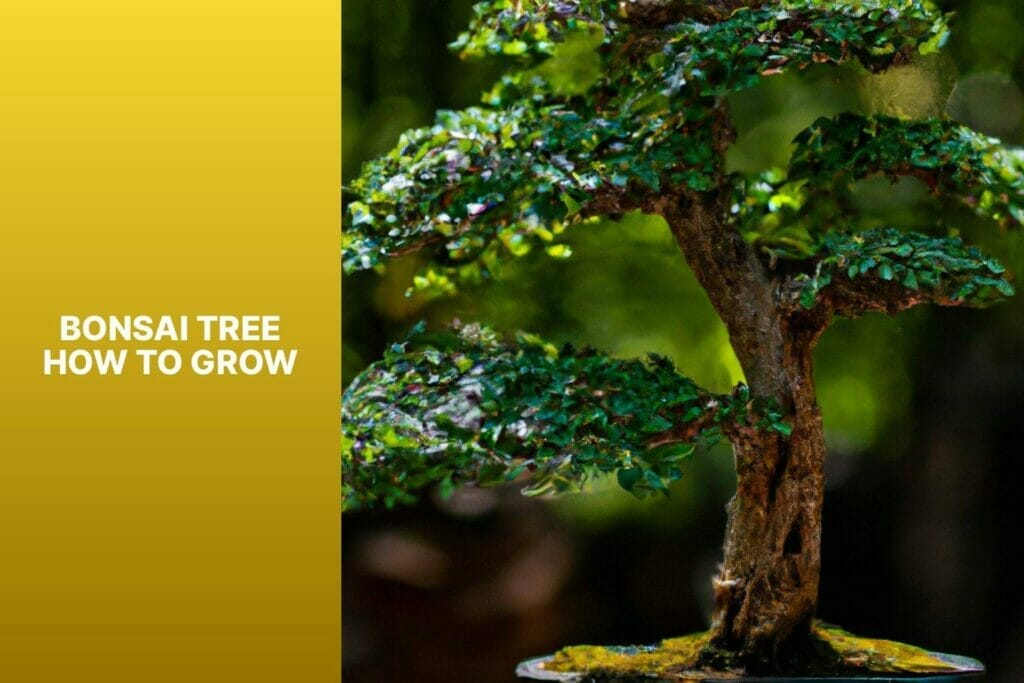Bonsai trees have captivated people with their miniature size and intricate beauty for centuries. But are bonsai trees natural? Let’s explore this fascinating subject to understand the nature of bonsai trees.
Bonsai trees are a form of art that originated in China and developed further in Japan. They are created through careful cultivation and pruning techniques to maintain their small size while mimicking the appearance of mature natural trees.
But are bonsai trees considered natural?
To answer this question, we need to define “natural.” “natural” refers to something that exists or occurs in nature without human intervention.
Bonsai trees, on the other hand, are meticulously shaped and cultivated by skilled artists known as bonsai masters. They are created through specific techniques that involve careful pruning, wiring, and shaping.
Bonsai trees are both natural and artificial creations. The raw material used for bonsai trees is a regular tree, which is then manipulated to create the desired aesthetic.
While not naturally occurring in the wild, bonsai trees imitate large, mature trees’ natural beauty and characteristics.
What makes bonsai trees truly artistic is their ability to evoke emotion and capture the essence of nature within a small-scale creation.
Bonsai artists meticulously work on every aspect, from the arrangement of branches and foliage to the shaping of the trunk, to create a harmonious and visually striking composition.
Despite their carefully manipulated appearance, bonsai trees fundamentally differ from naturally grown trees. They are confined to small containers, limiting their growth and shaping their unique miniature form.
Bonsai trees require ongoing care and maintenance to preserve this delicate balance between nature and art.
While bonsai trees are not meant to survive in the wild due to their specific cultivation techniques, they offer a range of benefits for enthusiasts.
They can bring a sense of tranquility, mindfulness, and connection to nature. Bonsai trees also provide an opportunity for artistic expression and creativity.
It is important to consider the environmental impacts of bonsai tree cultivation. Bonsai trees require regular pruning, watering, and fertilizing, which can affect resource consumption and waste generation.
Responsible bonsai enthusiasts prioritize sustainable and eco-friendly practices to minimize their environmental footprint.
- Bonsai trees are not natural in the traditional sense since they are created through a meticulous cultivation process.
- Despite being artificially cultivated, bonsai trees are considered natural art due to their aesthetic qualities and representation of nature.
- Bonsai trees require special care and cannot survive in the wild without human intervention.
- Having bonsai trees offers benefits such as stress relief, improved focus, and a deeper appreciation for nature’s beauty.
- Although bonsai tree cultivation has some environmental impacts, this hobby’s sustainability depends on using sustainable practices and materials.
What Are Bonsai Trees?
Bonsai trees are small trees that are carefully cultivated and pruned to create aesthetically pleasing replicas. They are not naturally occurring but are created through a meticulous process.
Regular care and attention are required to maintain their small size and artistic form. Bonsai trees are often grown in containers and are popular among gardening enthusiasts for their unique beauty and sense of tranquility.
They have gained worldwide popularity and are appreciated by people from various cultures.
Pro-tip: When selecting a bonsai tree, consider factors such as the tree species, size, shape, and the level of experience required for care. Start with beginner-friendly species like a Juniper or Ficus and progress to more challenging varieties as your skills improve. Research and understand the specific care requirements for each bonsai tree to ensure its health and longevity.
Are Bonsai Trees Natural?

Photo Credits: Mnbonsainetwork.Com by Gabriel Rivera
Bonsai trees are not naturally found in nature. They are created through a process called bonsai cultivation. This involves shaping small trees to resemble full-sized trees found in nature.
Bonsai trees are made by pruning, wiring, and training the branches and roots to stay miniature. Although the trees are real living plants, the unique shapes and miniature sizes of bonsai trees do not occur naturally.
The art of bonsai cultivation originated in ancient China and Japan to bring nature into homes and create a sense of tranquility and harmony.
Nowadays, bonsai trees are highly popular as decorative houseplants and artistic creations.
During a visit to a bonsai exhibition, I was astonished by the intricate beauty of the trees on display. Each tree had its own captivating story, with elegantly twisted branches and delicate foliage.
Discovering that these miniature masterpieces resulted from years of diligent cultivation and artistic vision was truly captivating.
The meticulous attention to detail and unwavering dedication to creating and maintaining bonsai trees is remarkable.
This experience instilled a profound appreciation for the artistry behind each bonsai tree and the skill of the bonsai cultivators who breathe life into these miniature landscapes.
What is the Definition of “Natural”?
“natural” refers to something inherent and not artificially altered or manufactured. Within bonsai trees, there is often a debate about what exactly constitutes “natural.” Bonsai trees are meticulously created through pruning, shaping, and training.
Although they originate from naturally grown trees, bonsai trees are regarded as artistic creations rather than natural phenomena.
The objective behind cultivating Bonsai is to replicate the appearance of mature trees in a miniature form, highlighting the beauty and essence of nature.
The manipulation and intervention involved in their creation challenge the concept of naturalness.
Even though bonsai trees do not occur naturally, they still embody elements of the natural world and evoke a sense of nature’s beauty and tranquility.
The artistry and skill required in their cultivation make them a distinctive and captivating form of plant artistry.
Therefore, while bonsai trees may not strictly align with the definition of “natural,” they hold a special place as a harmonious blend of artistic expression and natural inspiration.
How Are Bonsai Trees Created?
Bonsai trees are created with precise techniques and care. Here are the steps to create bonsai trees:
1. Select a suitable tree species for Bonsai, such as juniper, pine, maple, or elm.
2. Trim and shape the tree’s branches and foliage to achieve the desired bonsai shape.
3. Use aluminum or copper wire to carefully wrap and shape the tree’s branches, allowing for controlled growth.
4. Regularly report the bonsai tree to provide fresh soil and prevent root congestion. Repotting also includes root pruning.
5. Provide adequate water and nutrients to the bonsai tree, depending on the tree species and environmental conditions.
6. Carefully bend and shape the tree’s branches using wires to train it and create the desired artistic form and balance.
7. Regularly maintain the bonsai tree by removing dead or damaged branches and controlling pests and diseases. Pruning and upkeep are crucial for health and aesthetic appeal.
By following these steps, bonsai enthusiasts can create and cultivate living works of art like miniature trees.
Are Bonsai Trees Considered Natural Art or Artificial Creations?
Bonsai trees are considered natural art, not artificial creations. Originating in China and refined in Japan, Bonsai involves cultivating and shaping small trees to mimic full-grown trees in nature.
This art form requires skill to prune and train the tree, creating a miniature representation of nature.
Bonsai trees are not genetically modified or artificially created. Living organisms are nurtured and trained to achieve their desired form over time. Bonsai aims to capture nature’s beauty and essence in a small, contained form.
While bonsai techniques may involve shaping and pruning for aesthetics, the trees are not artificial. Living plants require proper care, including watering, sunlight, and regular maintenance.
Bonsai artists aim to achieve a harmonious balance between the natural growth patterns of the tree and their artistic vision.
What Makes Bonsai Trees Artistic?
Bonsai trees are considered artistic due to their unique design and cultivation techniques. The careful pruning and shaping of the tree’s branches and foliage result in a miniature representation of a full-sized tree.
Bonsai artists use trimming and wiring techniques to create intricate and beautiful designs that showcase the tree’s natural beauty.
In addition, the artistry of Bonsai extends to the presentation, which involves choosing the appropriate pot, arranging rocks, and composing the overall display.
The meticulous attention to detail separates bonsai trees from their naturally grown counterparts. Bonsai artists consider balance, proportion, and harmony to produce visually appealing compositions.
They draw inspiration from nature to capture the essence of a full-sized tree on a smaller scale.
Bonsai is more than just creating visually appealing tree-like objects. It is a form of art that requires skill, patience, and a profound understanding of horticulture.
Bonsai artists dedicate years to mastering techniques and nurturing their trees. The result is a living masterpiece that evokes emotions and brings tranquility and beauty to those who appreciate it.
Bonsai trees have a rich history that spans over a thousand years. While originating in China, the cultivation techniques of Bonsai were later adopted and refined by the Japanese.
This art form has now spread worldwide, captivating enthusiasts and artists alike. Bonsai trees are admired for their beauty and revered for symbolizing harmony, balance, and the unity of nature and humanity.
Today, bonsai trees are appreciated as an art form that encourages contemplation, mindfulness, and a deep connection with the natural world.
How Do Bonsai Trees Differ from Naturally Grown Trees?
Bonsai trees differ from naturally grown trees in several ways. They are intentionally dwarfed through pruning and root control techniques, which allows them to be kept small and fit into containers.
This creates the illusion of a mature tree in miniature form. Unlike naturally grown trees, Bonsai trees are shaped and trained to have unique growth patterns. They can have twisted trunks, windswept branches, or other artistic styles.
In terms of maintenance, bonsai trees require frequent pruning to maintain their desired shape and size. This pruning is unnecessary for naturally grown trees, as they can grow freely and develop their natural form.
The root systems of bonsai trees are also restricted due to being planted in small containers. This controlled root environment affects their growth and development, resulting in a different structure than naturally grown trees with expansive root systems.
While bonsai trees can live for many years with proper care, their lifespan is generally shorter than naturally grown trees. The confined environment and intensive maintenance practices can impact their overall longevity.
These differences contribute to bonsai trees’ unique aesthetic and artistic appeal, distinguishing them from naturally grown trees.
By understanding these distinctions, one can appreciate the craftsmanship and care involved in cultivating bonsai trees as living works of art.
Can Bonsai Trees Survive in the Wild?
Bonsai trees, miniature versions of larger trees, face limitations when surviving in the wild. Their ability to adapt to different environmental conditions is a factor to consider.
Bonsai trees are pruned and shaped to stay small, but they struggle to compete with larger trees and plants for sunlight, water, and nutrients in the wild.
Their root systems may not develop properly in shallow pots, hindering their growth and survival in the wild. Extreme weather conditions like strong winds, frost, and drought can also threaten bonsai trees.
When exposed to the natural environment, they are vulnerable to attacks from pests, diseases, insects, animals, and pathogens.
While certain bonsai tree species may be able to survive in specific wild habitats under favorable conditions, most would struggle to adapt and thrive outside controlled settings.
Therefore, providing bonsai trees with the necessary care and attention in a controlled environment is best to ensure their survival. Can bonsai trees survive in the wild? It is unlikely unless the conditions are ideal and their needs are met.
What are the Benefits of Having Bonsai Trees?
Having bonsai trees brings numerous benefits to your life and surroundings. Here are some of the benefits:
- Stress relief: Bonsai trees reduce stress and promote relaxation. Caring for these trees can be therapeutic and provide a mindful activity to unwind.
- Improved indoor air quality: Bonsai trees act as natural air purifiers, filtering toxins and releasing oxygen. They enhance the quality of the air you breathe, leading to a healthier environment.
- Enhanced focus and concentration: Growing and nurturing bonsai trees requires patience and attention to detail. This hobby cultivates focus and concentration skills as you carefully care for the tree.
- Aesthetically pleasing: Bonsai trees are beautiful and visually appealing. They enhance the aesthetic of any space, indoors or outdoors, adding a touch of nature and tranquility.
- Connection with nature: Bonsai trees allow you to connect with nature, even in busy urban areas. They link to the natural world and help you appreciate the beauty and wonder of nature.
Pro-tip: When selecting a bonsai tree, choose a species that suits your environment and lifestyle. Each species has its requirements, such as sunlight and watering needs. Doing research beforehand ensures the bonsai tree thrives in your care.
Are Bonsai Trees Considered a Sustainable or Eco-friendly Hobby?
Bonsai trees are considered a sustainable and eco-friendly hobby for several reasons. First, bonsai trees are cultivated from regular trees by pruning and training, reducing the need for continuous tree harvesting from forests.
This practice helps in conserving natural resources. Additionally, bonsai trees grown in small pots require less water, soil, and fertilizer than full-sized trees, contributing to resource conservation.
With proper care, bonsai trees can live for many years, allowing enthusiasts to enjoy their beauty without constantly buying new plants.
This longevity and reuse aspect further promotes sustainability. Bonsai enthusiasts often cultivate and care for rare or unique tree varieties, which contributes to the conservation of tree species diversity, thus promoting biodiversity.
Involvement in the bonsai hobby also fosters a deep appreciation for nature and the environment, encouraging further actions promoting sustainability.
For those starting with Bonsai, it is advisable to choose locally sourced and native tree species. This supports the local ecosystem and reduces the risk of introducing invasive species.
Opting for organic and sustainable soil composition and fertilization practices is crucial for an eco-friendly approach to bonsai care.
What Are the Environmental Impacts of Bonsai Tree Cultivation?
Bonsai tree cultivation can have environmental impacts. What are the environmental impacts of bonsai tree cultivation? Consider the following:
1. Water usage: Bonsai trees require regular watering, which can lead to increased water consumption compared to naturally grown trees. To minimize the environmental impact, use drip irrigation or collect rainwater.
2. Pesticide and fertilizer use: Some bonsai enthusiasts may use pesticides and fertilizers. Choose environmentally friendly and organic options, using them sparingly.
3. Soil erosion: Keeping trees in small pots can lead to soil erosion during watering or heavy rainfall. Prevent this by using proper soil mixtures and mulching.
4. Energy consumption: In colder climates, bonsai trees may need indoor or heated greenhouse protection from frost. This increases energy consumption. Use energy-efficient heating methods or choose bonsai species tolerant to colder temperatures.
5. Waste management: Bonsai tree cultivation generates waste materials like trimmed branches and pruning waste. Proper disposal or recycling is needed to minimize environmental impact.
Bonsai tree enthusiasts should be aware of these impacts and take appropriate measures to mitigate them. With sustainable practices, bonsai tree cultivation can coexist responsibly and eco-friendly with the environment.
Some Facts About Whether Bonsai Trees are Natural:
- ✅ Bonsai trees are not genetically modified but an art form that involves growing miniature trees in containers. (Source: BonsaiEmpire)
- ✅ Bonsai can be created from almost any woody plant and does not require genetically dwarfed trees. (Source: Wikipedia)
- ✅ Bonsai uses cultivation techniques such as pruning, root reduction, and potting to keep the trees small and mimic the shape of mature trees. (Source: Wikipedia)
- ✅ Bonsai originated from the Chinese art form of penjing and was introduced to Japan during the Tang dynasty. (Source: Wikipedia)
- ✅ Bonsai has become a popular art form and hobby millions worldwide enjoy. (Source: Wikipedia)


